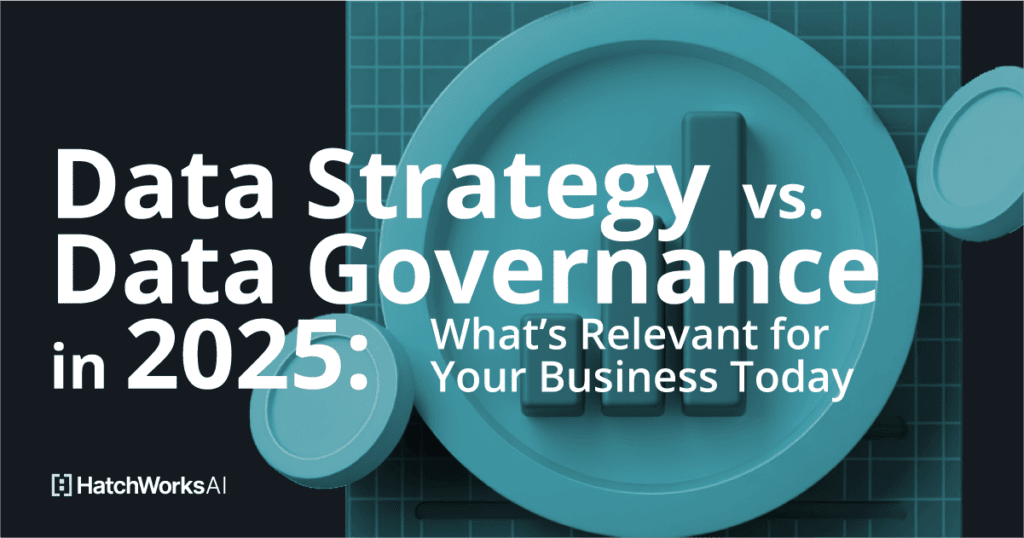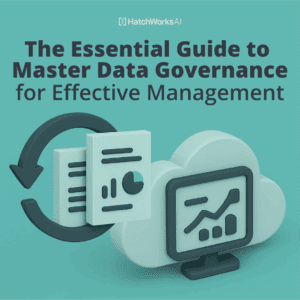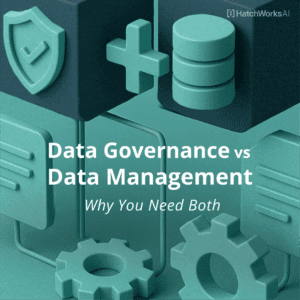To build a successful data-driven culture in 2025, your business needs both a clear data strategy and strong data governance. But what’s the difference—and why does it matter?

The Basics of Data Strategy and Data Governance
What is Data Strategy?
A data strategy is the master plan guiding how an organization collects, uses, and manages data to achieve long-term business goals. It shows you where you’re headed and the best routes to get there.
Don’t confuse data strategy with data management though. Data management is all about making day-to-day data operations run smoothly and your data strategy is looking at the bigger picture. It spans several areas, including data governance, data architecture, data quality management, and data lifecycle management.
What is Data Governance?
Data governance is the framework you follow to manage your data’s:
- Availability
- Usability
- Integrity
- Security
It ensures everyone in your organization knows everyone knows who’s responsible for what and how information should be handled.
It creates a structured environment, helping your business meet compliance standards, maintain consistency across data sets, and secure sensitive information against unauthorized access.
And because of that, it’s critical for regulatory compliance with laws like GDPR and HIPAA.
Data Strategy vs. Data Governance
Definitions aside, what is the difference between data strategy and data governance?
An effective data strategy focuses on the why. A successful data governance program focuses on the how.
While your strategy is informed by business goals, desired outcomes, and value creation from your data, your governance framework is inclusive of processes, policies, and enforcement.
However, these concepts don’t exist in isolation. They overlap significantly, especially when it comes to data quality, actionable insights, and inter-departmental collaboration. Both rely on strong partnerships between IT, business teams, and leadership.
You’ll need both to manage data in a way that benefits your business.
Here’s a quick side-by-side comparison:
| Data Strategy | Data Governance | |
|---|---|---|
|
Goal
|
Align data usage with long-term business vision.
|
Ensure data is accurate, secure, and compliant.
|
|
Scope
|
Long-term, strategic initiatives
|
Daily operational management and compliance
|
|
Responsibility
|
Executive leadership, data strategy leaders
|
IT, data stewards, compliance teams
|
|
Metrics
|
Business impact, growth, ROI
|
Data quality, accuracy, compliance standards
|
Reflecting on Your Data Approach
- What challenges have you encountered in aligning strategic vision with operational compliance?
- Which roles or teams in your organization are key to bridging this gap?
How Data Quality Connects Data Strategy and Data Governance
If your data isn’t accurate, consistent, or trustworthy, even the smartest strategies and most thorough governance policies won’t succeed.
Strategically, poor-quality data leads to flawed insights and misguided decisions. This can impact anything from revenue forecasting to miscalculated market opportunities.
From a governance perspective, poor data quality creates immediate compliance and operational challenges. If data is incomplete, inconsistent, or incorrect, it becomes difficult to uphold regulations like GDPR or HIPAA. You can easily trigger regulatory fines, security breaches, or reputational damage.
But when your data quality is high, you build a powerful foundation to drive business growth. Reliable data allows you to quickly spot opportunities, anticipate customer needs, and stay ahead of competitors—turning insights into actions that directly impact your bottom line.
Ensuring Data Quality and Compliance
- What metrics do you currently use to evaluate data accuracy and consistency?
- How might improved data quality enhance decision-making and drive better business outcomes?
Why Businesses Need Both Data Strategy and Data Governance in 2025
Without strategy and governance, your company risks either dreaming big but never executing or managing data without purpose.
A strong data strategy gives your business direction. It helps you pinpoint exactly how data can boost customer satisfaction, revenue growth, and innovation. But without governance also in place, it doesn’t matter how strong your strategy is. Your data will remain scattered, insights will be inconsistent, and trust (from both employees who use the data and customers who see the data) will erode.
Data governance can’t exist on its own either. If it’s disconnected from your business goals it’s aimless.
Let’s look at it through the lens of a major retailer hoping to use AI to personalize customer experiences.
Their data strategy is able to identify personalization as a growth priority for the business while data governance creates trusted insights that AI can leverage to increase sales, such as items the customer has looked at before.
Key Components of a Modern Data Strategy
An effective data strategy in 2025 includes four core elements working together to deliver meaningful business results:
| Component | Role in Data Strategy |
|---|---|
|
Data Collection
|
Identifying and capturing the right data from reliable sources is foundational. Successful companies use modern tools, including automated data pipelines, IoT devices, APIs, and customer touchpoints, to gather data quickly, consistently, and accurately.
|
|
Data Analytics
|
Raw data on its own isn't valuable—it's the insights hidden within that truly matter. Data analytics transforms your collected data into actionable intelligence, enabling better decision-making, clearer forecasting, and more targeted customer engagement.
|
|
A Robust Technology Stack
|
A robust tech stack—including cloud infrastructure, AI platforms, and machine learning—is essential for processing and analyzing large datasets. Choosing scalable, secure, and adaptable technologies helps your business respond rapidly to market shifts and customer demands.
|
|
Alignment with Business Goals
|
The ultimate test of your data strategy is whether it supports measurable business objectives. Clearly defined KPIs, directly linked to outcomes such as revenue growth, customer retention, or operational efficiency, keep your data initiatives focused and accountable.
|
Leveraging Your Technology Stack
- How does your current technology infrastructure support efficient data collection and advanced analytics?
- How do you ensure that the insights generated from your analytics translate into actionable business intelligence?
Pillars of Effective Data Governance
Effective data governance relies on clear, foundational pillars that ensure your data is well-managed. They are:
1. Assigning Data Ownership
Clearly assigning accountability within teams ensures everyone knows their roles and responsibilities. Data owners become stewards who oversee accuracy, consistency, and security, driving effective data governance processes throughout your organization.
They may even start data literacy programs to help your teams understand the data they work with.
2. Establishing Data Policies
Well-defined policies guide how your teams access, use, and share data. These policies set standards for data security, privacy, and compliance, establishing trust both internally and externally.
3. Consistent Data Management
Continuous improvement of data accuracy and reliability is essential. Effective data governance processes include regular audits, cleansing, and validation—making sure your data consistently supports smart business decisions.
4. Guaranteed Regulatory Compliance
Compliance with regulations like GDPR and CCPA isn’t optional. Data governance ensures your business consistently meets these requirements, protecting your company from legal risks while strengthening customer confidence.
💡 Looking for smarter data strategies? Check out our comprehensive guide on Data Governance Pillars.
Implementing Robust Data Governance
- How do you assign data ownership within your teams to ensure accountability?
- How do you integrate regular audits and validations into your governance framework?
Best Practices for Data Governance and Data Strategy
The below is a whistle-stop tour of some best practices we follow and encourage our clients to follow as well.
Collaboration, Documentation, and Tools
Effective data governance and strategy depend on clear collaboration and practical documentation.
Teams across your business need to understand their roles, share knowledge, and stay on the same page when managing valuable data assets.
Take the time to create documentation that lists your governance policies and make sure your rules are easy to follow. A well-defined data governance framework and data strategy outline are critical for successful data management.
And because data governance and strategy need ongoing attention, regular check-ins and improvements will ensure your data practices evolve alongside your business objectives, maximizing the long-term value of your data assets.
Choosing the right tools also matters. We’re a Databricks partner and we trust them to simplify data governance, especially for use in AI.
The Databricks Unity Catalog centralizes how you organize, access, and secure your data making collaboration effortless for engineers, analysts, and data scientists.

Data Governance Resources You Need Right Now
We have heaps of content covering everything you need to know about data governance, management, and strategy. Check them out below:Get Your Data AI Ready
Partner with HatchWorks AI to assess your AI Data Readiness and Governance to create a clear path to AI success.




